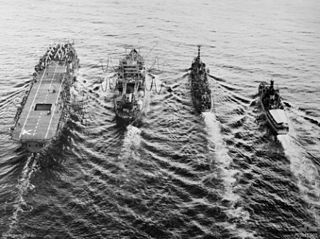Related Research Articles
Seven ships of the Royal Navy have borne the name HMS Niger after the Niger River, whilst another was planned.
Eleven ships of the Royal Navy have been named HMS Scorpion after the carnivorous arthropod, or the scorpion, a ballistic weapon in use in the Roman army:

HMS Bee was an Insect-class gunboat of the Royal Navy, launched on 8 December 1915. This class are also known as "Large China Gunboats".

HMS Alert a Bay-class frigate of the Royal Navy. She was originally laid down as the Loch-class vessel Loch Scamdale, and re-ordered as Dundrum Bay while building. She was completed as Alert, an Admiralty Yacht for command and gunboat diplomacy duties in the Mediterranean and Far Eastern stations.

The fourth HMS Dominica (K507) was a Colony-class frigate of the United Kingdom which served in the Royal Navy during World War II. She originally was ordered by the United States Navy as the Tacoma-class patrol frigateUSS Harman (PF-79) and was transferred to the Royal Navy prior to completion.

HMS Peony was a Flower-class corvette of the Royal Navy. In 1943 she was transferred to the Royal Hellenic Navy as RHNS Sachtouris, serving throughout World War II and the Greek Civil War. She was returned to the Royal Navy in 1951 and scrapped in April 1952.
HMS Dittany was a Flower-class corvette of the British Royal Navy during the Second World War.
HMS Zanzibar (K596) was a Colony-class frigate of the United Kingdom that served during World War II. She was ordered by the United States Navy as the Tacoma-class patrol frigateUSS Prowse (PF-92) and was transferred to the Royal Navy prior to completion.

HMS Antigua (K501) was a Colony-class frigate of the United Kingdom in commission from 1943 to 1945 that served during World War II. She originally was ordered by the United States Navy as the Tacoma-class patrol frigateUSS Hamond (PF-73) and was transferred prior to completion.
The fourth HMS Tobago (K585), ex-Hong Kong, was a Colony-class frigate of the United Kingdom which served in the Royal Navy during World War II. She originally was ordered by the United States Navy as the Tacoma-class patrol frigateUSS Holmes (PF-81) and was transferred to the Royal Navy prior to completion.
HMS Perim (K593), ex-Sierra Leone, was a Colony-class frigate of the United Kingdom that served during World War II. She originally was ordered by the United States Navy as the Tacoma-class patrol frigateUSS Phillimore (PF-89) and was transferred to the Royal Navy prior to completion.
HMS St. Helena (K590) was a Colony-class frigate of the United Kingdom that served during World War II. She originally was ordered by the United States Navy as the Tacoma-class patrol frigateUSS Pasley (PF-86) and was transferred to the Royal Navy prior to completion. After the British returned her to the United States in 1946, she briefly carried the name USS St. Helena (PF-86).
HMS Sarawak (K591) was a Colony-class frigate of the United Kingdom that served during World War II. She originally was ordered by the United States Navy as the Tacoma-class patrol frigateUSS Patton (PF-87) and was transferred to the Royal Navy prior to completion.
HMS Veronica was a Flower-class corvette, built for the Royal Navy during the Second World War, and was in service in the Battle of the Atlantic. In 1942 she was transferred to the United States Navy as part of the reverse Lend Lease arrangement and renamed USS Temptress, the name ship of the Temptress-class gunboats. With the end of hostilities she was returned to the Royal Navy and sold into mercantile service.
HMS Candytuft was a Flower-class corvette, built for the Royal Navy during the Second World War, and was in service in the Battle of the Atlantic. In 1942 she was transferred to the United States Navy as part of the reverse Lend Lease arrangement and renamed USS Tenacity, one of the Temptress-class gunboats. With the end of hostilities she was returned to the Royal Navy and sold into merchantile service.

HMS Tarantula was an Insect-class gunboat of the Royal Navy. Launched in 1915, the gunboat saw service in both the First and Second World Wars. Tarantula served with the Tigris flotilla in 1916, retaking a former British gunboat that had previously been captured by the Ottoman Empire. After the First World War, Tarantula was towed to China, joining the China Station, eventually ending up at Trincomalee, Ceylon during the Second World War. After the end of the war, the vessel was sunk as a gunnery target in the Bay of Bengal in 1946.
EIght Royal Navy vessels have borne the name HMS Mastiff, named after the mastiff, a type of dog:
HMS Cuckmere (K299) was a River-class frigate of the Royal Navy (RN) in 1943. Cuckmere was originally to be built for the United States Navy, having been laid down as PG-104, but was transferred to the Royal Navy as part of Lend-Lease and finished to the RN's specifications as a Group II River-class frigate. She was first Royal Navy ship to carry the name Cuckmere.

HMS Lagan (K259) was a River-class frigate of the Royal Navy (RN). Lagan was built to the RN's specifications as a Group II River-class frigate. She served in the North Atlantic during World War II.
HMS Tern was a river gunboat built for the Royal Navy by Yarrow in 1927.
References
- ↑ "HMS Scorpion (T67) (1942)". Wrecksite.eu. Retrieved 14 May 2023.
- ↑ "HMS Scorpion (i) (T 67) of the Royal Navy - British River gunboat of the Scorpion class - Allied Warships of WWII - uboat.net". uboat.net.